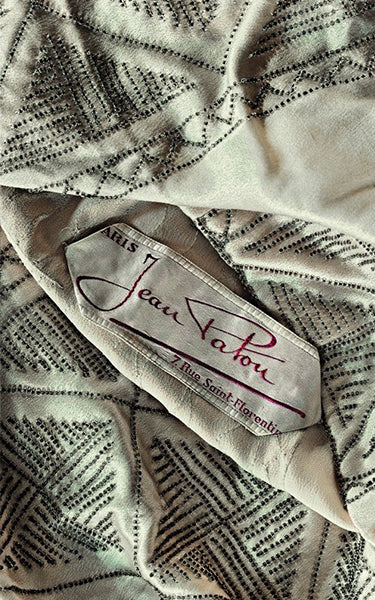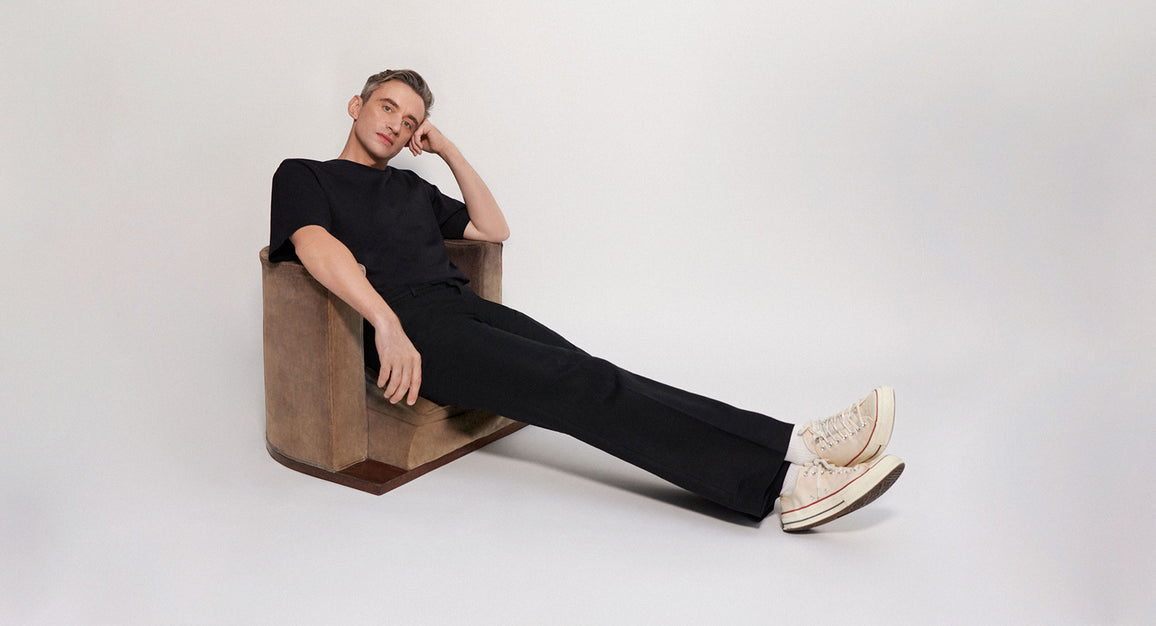The Story of the Maison
A young house with a century-old history...
The Story of the Maison
Jean Patou founded his eponymous house in 1914. The First World War brought the house to an unexpected halt. When he returned from the front, he relaunched the brand. His first creations were inspired by his travels in the Balkans and the East. The young couturier wanted to free women from the restrictive clothing imposed on them up until then. He marketed dresses without corsets, shortened skirts, launched a sports line designed to be worn in town and a monogram with his initials. He stood out from his competitors, Jeanne Lanvin and Gabrielle Chanel, his great rival, by being all the more visionary. For example, he made tennis champion, Suzanne Lenglen, his muse, designing long dresses with low necklines on the back when the boyish style was in vogue. His eye paid off: between 1919 and 1924, the house’s revenue increased thirtyfold. Celebrities of the time, such as Louise Brooks, Josephine Baker and Mistinguett, were all seen wearing his dresses.
His shop on rue Saint-Florentin in Paris attracted the elite and high society. The 1929 crisis impacted the house, just as he was opening New York. Jean Patou created "Joy", the most expensive perfume in the world, to relaunch his brand. His death in 1936 from a stroke brought the adventure to an end. After the shock of his passing, Madeleine Patou, his sister, and Raymond Barbas, her husband, took over the reins of the house.
Without its founder, the Jean Patou brand lost its aura. Marc Bohan took over the artistic direction in 1954. Following his lead, the house has seen some of the greatest names of fashion at its helm: Karl Lagerfeld, Michel Goma, and under his direction, Jean Paul Gaultier made his debut there, followed by Angelo Tarlazzi and Christian Lacroix. After Christian Lacroix left to start his own house, the Jean Patou house ceased its activity.
Perfumes can keep a name alive. "Joy" has remained a reference fragrance, one of the great commercial successes of the perfume industry. The Procter & Gamble group marketed it from 2001 to 2011, before the English group Designer Parfums took over.
Jean Patou was acquired in 2018 by the LVMH group - which signed a strategic agreement with Designer Parfums to take over the clothing division. Sidney Toledano has appointed Guillaume Henry to the artistic direction, entrusting him with the task of relaunching his women's ready-to-wear lines.
Jean Patou, The most Elegant man in Europe!

Jean Patou, The most Elegant man in Europe!
Born in Paris in 1887 into a family of tanners based in Picardy, Jean-Alexandre Patou, renamed Jean Patou, first joined the army before turning his eye to fashion. His father was a tanner of chamois for luxury leather goods and his mother, a housewife. He trained in fur before founding his first fashion house at the age of 23, then created his own brand in Paris in 1914. The First World War forced him to put his brand on hold. After returning from the front, where he discovered the beauty of the East and the Balkans, he re-opened his house as a family business, alongside his parents, his sister, Madeline, and her husband.
A dandy of the Roaring Twenties and an enlightened aesthete with impeccable taste, he travelled all over Europe and the United States, with an eternal cigarette between his fingertips. The American press describes him as "the most elegant man in Europe". A socialite, Jean Patou liked to party and dine at Maxim's. He himself organized evening runway shows that sometimes went on until the early morning. Infatuated with high speed and thrills, Jean Patou drove racing cars, gambled at casinos, and sailed speedboats on the open sea. A man in motion, Patou was always pulling forward.
In the 1920s, women were breaking the mould with their wardrobe, and Jean Patou was at their side. He proposed a whole new way to experience garments and the idea of leisure and relaxation. Freedom, in short.... Jean Patou shared romances with Louise Brooks and members of the European aristocracy but never married anyone.
In 1925, the year of his great successes, he opened a shop in Monte-Carlo, which he frequented for its casino. In Deauville, Cannes and Biarritz, seaside resorts where one had to be seen, he sold bathrobes and swimwear made to measure, marked with his initials: "JP". Jean Patou participated in the emergence of the iconic French "je ne sais quoi" movement that has left a lasting mark on French style.
Jean Patou died in his apartment of Georges V in 1936, at the age of 48, leaving the world with a spark as quick as was his life.
Jean Patou, the Pionneer!

Jean Patou, the Pionneer!
Jean Patou revolutionized fashion by liberating the female figure. The couturier designed dresses to wear without a corset and invented sportswear well ahead of his time, making tennis champion, Suzanne Lenglen, his first muse.
In the 1920s, he shortened the hemline, marketed a pleated skirt to wear in the city, and designed jersey sets with geometric patterns. A visionary fashion designer, Jean Patou invented the monogram, slipping his initials onto jersey swimwear, marked them with the "JP" of the house.
An anecdote tells a lot about the spirit of Patou, the pioneer: in the centre of his shop on rue Saint-Florentin, a stone's throw from Concorde, he created a "perfume bar" where he offered cocktails and perfumes that he made himself on the spot, extending an exceptional experience to his clients and their spouses.
Jean Patou also inaugurated "Le Coin des riens" (The Nook for Little Nothings) where he sold atypical accessories that were between fashion and design. In 1927, tanned skin was the new chic and Jean Patou conceived Chaldea oil, the first sunscreen product – never before seen.
An aesthete and lover of literature, the couturier named his clothes (coats such as "Il viendra” - He will come -, "Pour lui” - For him -, evening dresses called "Belle ténébreuse” - Mysterious Beauty, "Vierge folle“ - Wild Girl -, "Candide") and created perfumes, notably unisex, in collaboration with Baccarat and Van Cleef who designed the bottles. The 1929 crisis unfortunately hit the house as well.
He opened a boutique in New York, as his success spanned both sides of the Atlantic. He tried to save the brand by creating "Joy", "the most expensive perfume in the world", in 1930, offering "a few drops of joy" to his customers. Its prohibitive price (30 ml for the equivalent of a thousand euros) has made a legend of the scent and of the man behind it, Jean Patou.
Patou & the Designers taking over the Maison!

Patou & the Designers taking over the Maison!
Some of the biggest names in fashion have carried the brand’s creative torch after Jean Patou's death in 1936.
Marc Bohan, born in 1926, made his debut with Jean Patou at the age of 18. He left the couture house to better find himself as the artistic director. He kept the legend alive from 1954 to 1957. He moved on to serve as the head of creation at the Dior house for the following thirty years.
Karl Lagerfeld joined the fashion house as head designer in 1958, where he created the memorable long flowing dresses inspired by the 1930s, in homage to the founder. He left Jean Patou in 1963 to devote himself to ready-to-wear houses with whom he collaborated.
Michel Goma remained at the head of the fashion house from 1963 to 1974. He developed ready-to-wear in parallel with his couture work.
Jean Paul Gaultier began his career with Jean Patou during Michel Goma’s time there. He joined the studio in 1972 at the age of 20, completing his apprenticeship there. He left the house in 1974 to work at Pierre Cardin.
Angelo Tarlazzi took over the reins of Jean Patou in 1974, succeeding Michel Goma. He created “handkerchief” dresses made of knotted silk scarves that became his signature within the house. He left in 1977 to start his own brand.
During his time with Jean Patou in the 1980s, Christian Lacroix gave the brand a new life. Lacroix dared all the crossovers, unexpected combinations of colours, extravagant details (such as the famous tafetta hand-painted toile de jouy cocktail dress), and oriental inspirations reminiscent of those Jean Patou loved them at the time of his splendour. He received the prestigious Dé d'Or de la Couture award in 1986 for his work, before the fashion house ceased its activity in 1987 and Lacroix founded his eponymous house within the LVMH group.
